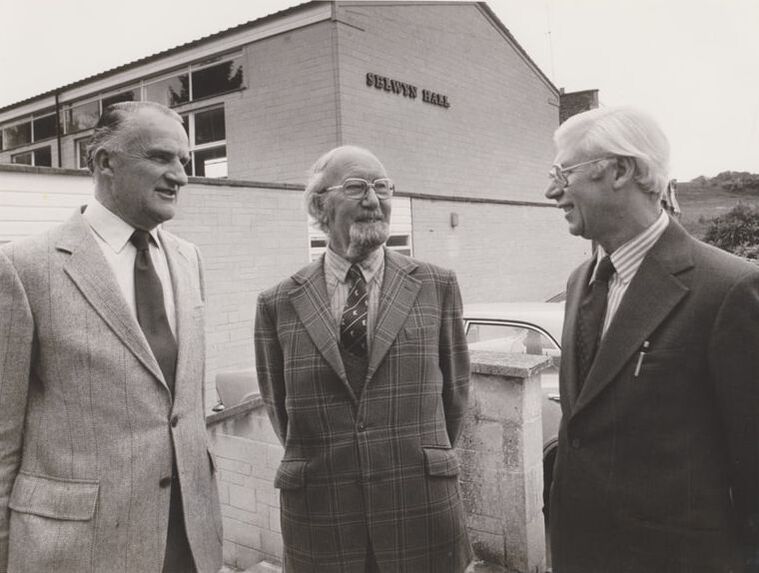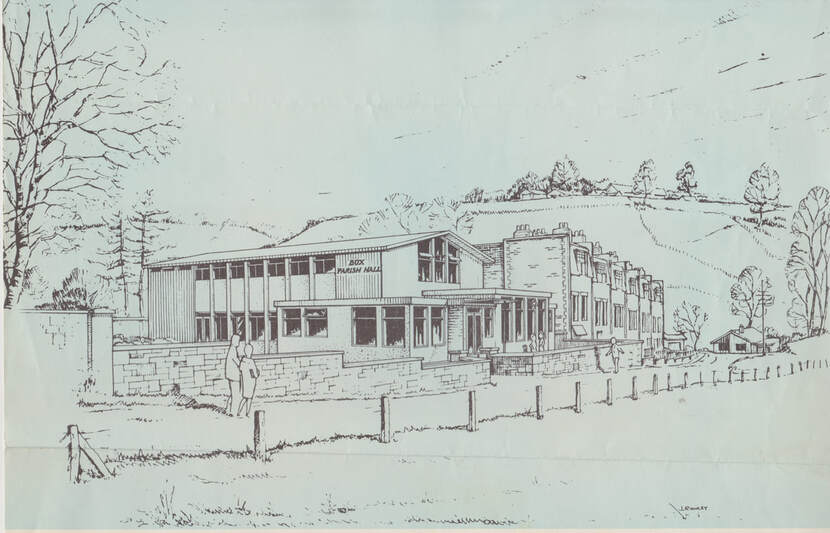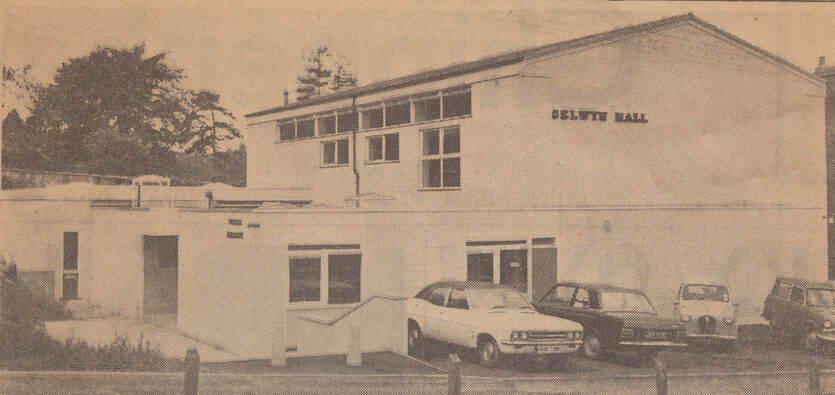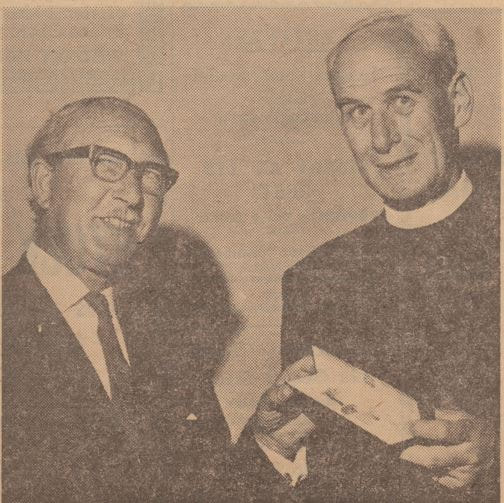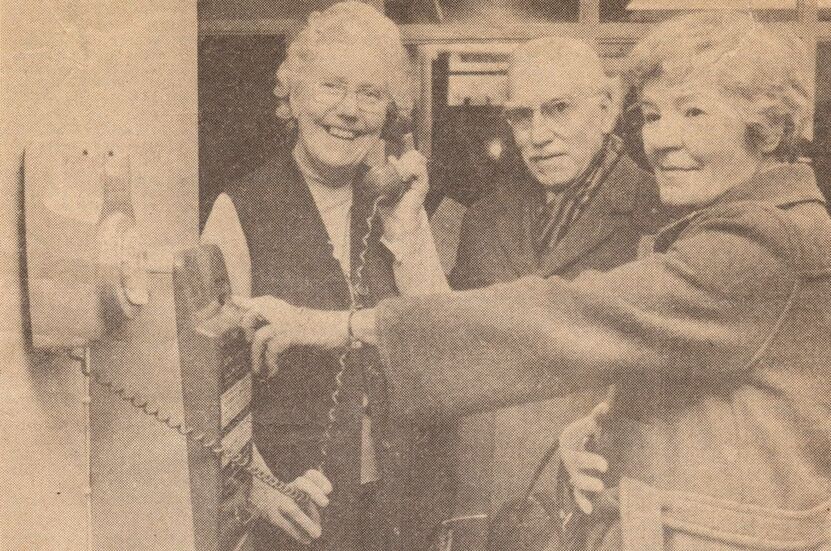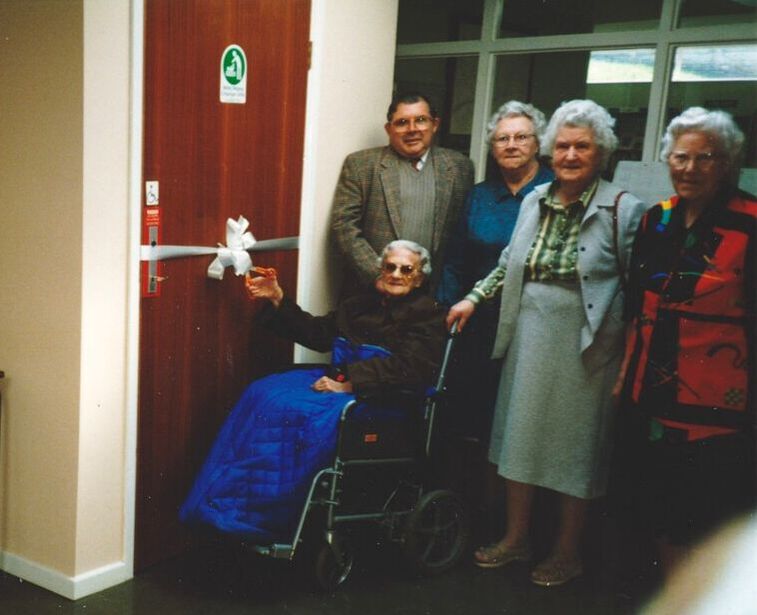Selwyn Hall, 1969 Alan Payne Research Documents Margaret Wakefield via Phil Lambert May 2023
We are so used to the Selwyn Hall as the village hall that we may have forgotten how recent the building is. Its origins were shrouded in difficulty because the gift of the land to the community had prohibited buildings and the development of the Recreation Field. Not only planning issues caused delay in the work: the building needed to be multi-purpose as theatre and sports hall and, of course, the discovery of more remains of the Box Roman Villa slowed progress. Against this background, time was running out for the old village hall, the Bingham Hall, before it was unusable. It is remarkable that the Selwyn Hall was ever constructed.
Early Plans
The earliest concept of a new Box village hall originated in March 1949 as a memorial achievement to commemorate the end of the Second World War. The idea was prompted by the trustees of the Bingham Hall who advised that the corrugated iron and wooden structure had approximately 15 years of life expectancy left. A committee of seven people was elected for a 3-year period, which raised £255 from local events including £84 from a garden party. Funds were totally insufficient for a new hall and the amount raised was used on the conversion of stables opposite the Queen’s Head into a public lavatory.
Thoughts returned to the plan in 1952 when a public meeting was held, suggesting that the parish council manage the project. The initiative lapsed again until June 1958 with another public meeting. By this time the funds raised had increased slightly to £349 but the parish council were out of consideration as they were prohibited from being a trustee of public funds. A further three years then lapsed trying to form an amalgamation with the Bingham Hall trustees and plans to develop The Rec into a sports facility. By 1958 it was back to square one and thoughts turned to rebuilding on the site of the Bingham Hall.
The project was resurrected in May 1961 when a new committee was formed with representatives from village clubs and organisations. Matters suddenly speeded up in 1966 when the Bingham Hall Trustees announced that the building would have to be closed within 4 years, setting a deadline date of July 1970. Another new management committee was formed in 1966 with a key group comprising Phil Lambert as chairman, Mike Sloper secretary and Nigel Bence treasurer. The project took a broader, village-wide approach with leaflets and a barometer image displayed on the school tower to indicate fundraising progress. Vicar Tom Selwyn-Smith offered to fund £1,000 if the hall could be built before August 1970. It was the pump-priming needed. He also offered part of his garden to be used as the site of the hall, and persuaded the owners of the land, the Church Commissioners, to agree. Under the chairmanship of Bill Chaffey, the parish council bought the area from the commissioners and leased it at a peppercorn rent to an independent Village Hall committee.
The earliest concept of a new Box village hall originated in March 1949 as a memorial achievement to commemorate the end of the Second World War. The idea was prompted by the trustees of the Bingham Hall who advised that the corrugated iron and wooden structure had approximately 15 years of life expectancy left. A committee of seven people was elected for a 3-year period, which raised £255 from local events including £84 from a garden party. Funds were totally insufficient for a new hall and the amount raised was used on the conversion of stables opposite the Queen’s Head into a public lavatory.
Thoughts returned to the plan in 1952 when a public meeting was held, suggesting that the parish council manage the project. The initiative lapsed again until June 1958 with another public meeting. By this time the funds raised had increased slightly to £349 but the parish council were out of consideration as they were prohibited from being a trustee of public funds. A further three years then lapsed trying to form an amalgamation with the Bingham Hall trustees and plans to develop The Rec into a sports facility. By 1958 it was back to square one and thoughts turned to rebuilding on the site of the Bingham Hall.
The project was resurrected in May 1961 when a new committee was formed with representatives from village clubs and organisations. Matters suddenly speeded up in 1966 when the Bingham Hall Trustees announced that the building would have to be closed within 4 years, setting a deadline date of July 1970. Another new management committee was formed in 1966 with a key group comprising Phil Lambert as chairman, Mike Sloper secretary and Nigel Bence treasurer. The project took a broader, village-wide approach with leaflets and a barometer image displayed on the school tower to indicate fundraising progress. Vicar Tom Selwyn-Smith offered to fund £1,000 if the hall could be built before August 1970. It was the pump-priming needed. He also offered part of his garden to be used as the site of the hall, and persuaded the owners of the land, the Church Commissioners, to agree. Under the chairmanship of Bill Chaffey, the parish council bought the area from the commissioners and leased it at a peppercorn rent to an independent Village Hall committee.
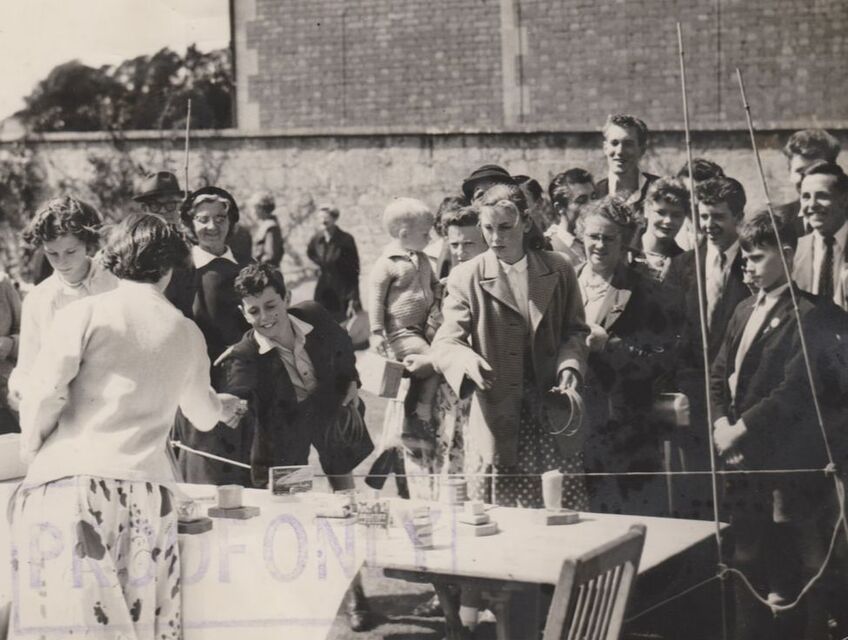
The Church Fete in the vicar’s garden about 1955 before the Hall was built. L-R Front: Sandra Ford, Sister Lillian, John Currant (boy in blazer), Mary Sully, Les Hinton's wife and Keith Davis Back: Michael Edwin Gibbons (tall), Right Derek Fowle, Howard Croker hidden, Mick Petty (courtesy John Currant)
Excavating the Site
The area was known to be on the site of a Roman villa and a team of archaeologists from Bristol University and a number of local volunteers were allowed a few months of excavation work under the supervision of Dr Henry Hurst. The group camped in the vicarage garden and became a source of interest to local residents, who volunteered to help. In September 1965 vicar Tom Selwyn-Smith reported that the extent of the excavation work had taken people by surprise. He said it covered the area of his garden, the bowling green and tennis court and went as far as Mr Brooke’s back gate at 2 Mead Villas.[1] This may have been rather fanciful on his part.
It was clear that expert archaeological work was needed and in December 1967 the Ministry of Public Building and Works sponsored a 4-week test excavation.[2] Further research excavation then took place in the gardens of The Wilderness and The Vicarage in the summer of 1968. In July 1968 the vicar was able to report on the discoveries: a Roman drain was opened from the foundations of the old villa in the vicarage garden. In another drain was found an almost complete clay roofing tile and a half pane of glass of Roman origin.[3] It was all very exciting stuff. The vicar captured the mood of the village: There is something of a thrill in seeing “Box Village Hall” written on girders awaiting to be installed. The excavation revealed that the villa area was much larger than originally believed and we still don’t know the full extent of the site or of its use. An excavation trench was dug that winter looking for the south-west extent of the villa. When time ran out, the excavations were backfilled and made ready for the erection of the village Hall building.
The area was known to be on the site of a Roman villa and a team of archaeologists from Bristol University and a number of local volunteers were allowed a few months of excavation work under the supervision of Dr Henry Hurst. The group camped in the vicarage garden and became a source of interest to local residents, who volunteered to help. In September 1965 vicar Tom Selwyn-Smith reported that the extent of the excavation work had taken people by surprise. He said it covered the area of his garden, the bowling green and tennis court and went as far as Mr Brooke’s back gate at 2 Mead Villas.[1] This may have been rather fanciful on his part.
It was clear that expert archaeological work was needed and in December 1967 the Ministry of Public Building and Works sponsored a 4-week test excavation.[2] Further research excavation then took place in the gardens of The Wilderness and The Vicarage in the summer of 1968. In July 1968 the vicar was able to report on the discoveries: a Roman drain was opened from the foundations of the old villa in the vicarage garden. In another drain was found an almost complete clay roofing tile and a half pane of glass of Roman origin.[3] It was all very exciting stuff. The vicar captured the mood of the village: There is something of a thrill in seeing “Box Village Hall” written on girders awaiting to be installed. The excavation revealed that the villa area was much larger than originally believed and we still don’t know the full extent of the site or of its use. An excavation trench was dug that winter looking for the south-west extent of the villa. When time ran out, the excavations were backfilled and made ready for the erection of the village Hall building.
Constructing the Building
The plan of the hall was based on the needs of the trustee groups on the management committee, including the groups who had used the old Bingham Hall: an assembly room for dancing, stage for plays, changing rooms for sports clubs, showers, 22-foot-high badminton area, toilets and kitchen area. Someone suggested a library could also be incorporated, replacing the small facilities which then existed in the Methodist Chapel schoolroom. The County Library were keen to be involved as they could increase the number of books available to borrow from 600 to 6,000 and they were prepared to contribute substantially to the cost of the building work. It was the first new library built in Wiltshire since the Second World War.[4]
The plan of the hall was based on the needs of the trustee groups on the management committee, including the groups who had used the old Bingham Hall: an assembly room for dancing, stage for plays, changing rooms for sports clubs, showers, 22-foot-high badminton area, toilets and kitchen area. Someone suggested a library could also be incorporated, replacing the small facilities which then existed in the Methodist Chapel schoolroom. The County Library were keen to be involved as they could increase the number of books available to borrow from 600 to 6,000 and they were prepared to contribute substantially to the cost of the building work. It was the first new library built in Wiltshire since the Second World War.[4]
Architects John Sharpe & Partners of Bath were appointed to design the proposed building and to estimate the quantity of materials needed. Local building firms were asked to tender for the work which went to Richard Best & Sons Limited of Box. Although it seems ridiculous now, the village was proud that it was constructed not of old Box stone but of the modern artificial stone. Having visited other local village halls, the committee declared the Box village hall Best in the West.[5] The original colour scheme in the main hall was peach on three walls, on the other contemporary-style red which gives a welcome splash of colour and a green ceiling.[6]
As plans evolved, costs gradually rose from an initial estimate of £13,000 (rejected at a village meeting as too expensive) to £16,000 and eventually settled at £24,000. Initially, the village was reluctant to consider these sums and only 14 people attended a public meeting in February 1966.[7] The committee worked on regardless. Funding commitments were received from the Department of Education & Science for a grant of £10,000, Wiltshire Education Committee £3,000, Wiltshire Library Service £6,000 and local fundraising was required for the balance of £5,000. But by March 1966 only £860 had been collected from the village, although local tradesmen offered to raise £2,500 more. At this point, the donation by Vicar Tom Selwyn-Smith could be called in and the project was suddenly viable. His generosity sparked village organisations into action: Box Boys’ Club gave £90 in August 1967, the girls of St John’s and the Scouts contributed; and the villagers organised cheese and wine parties and bric-a-brac stalls.[8] Most of the clubs wanting to be involved offered donations.[9] The committee offered a range of subscriptions to the general public - individual, family and group subscriptions for each of the following three years, founder membership at a higher level, and covenants lasting seven years.
As plans evolved, costs gradually rose from an initial estimate of £13,000 (rejected at a village meeting as too expensive) to £16,000 and eventually settled at £24,000. Initially, the village was reluctant to consider these sums and only 14 people attended a public meeting in February 1966.[7] The committee worked on regardless. Funding commitments were received from the Department of Education & Science for a grant of £10,000, Wiltshire Education Committee £3,000, Wiltshire Library Service £6,000 and local fundraising was required for the balance of £5,000. But by March 1966 only £860 had been collected from the village, although local tradesmen offered to raise £2,500 more. At this point, the donation by Vicar Tom Selwyn-Smith could be called in and the project was suddenly viable. His generosity sparked village organisations into action: Box Boys’ Club gave £90 in August 1967, the girls of St John’s and the Scouts contributed; and the villagers organised cheese and wine parties and bric-a-brac stalls.[8] Most of the clubs wanting to be involved offered donations.[9] The committee offered a range of subscriptions to the general public - individual, family and group subscriptions for each of the following three years, founder membership at a higher level, and covenants lasting seven years.
|
The hall was officially opened by the Box vicar Rev Thomas R Selwyn-Smith on 3 July 1969 in front of Sir Henry Langton (chairman of Wiltshire County Council), representatives from the Wiltshire Library Service, and a host of other VIPs. Also present were members from the eighteen organisations on the management committee and other local, interested people.
The vicar was presented with an engraved entrance key, giving him the freedom of the hall. But some issues remained to be resolved. A planning stipulation to provide between 50 and 100 car parking spaces was satisfied in 1971 when the parish council gave permission for part of the Lower Recreation Ground to be used for that purpose and leased it to the hall committee for a peppercorn rent for 99 years from 2 September 1968. However, the lease was contingent on the requirement to pay for a car park. Left: Phil Lambert hands over the keys to Tom Selwyn-Smith (courtesy Bath & Wilts Chronicle, 4 July 1969) |
Operating the Hall [10]
From the outset, the management committee comprised six elected members and twenty members as club representatives. The first elected members were Phil Lambert (chairman), Donald Sloper (vice-chairman), Mike Sloper (secretary), Nigel Bence (treasurer), RJ Hill and Margaret Currant. The original charges for using the main hall of the building started as £1 per hour for organisations on the management committee (raised to £2 per hour for fundraising events) and £2 per hour for private hire. For winter lettings £1 extra was charged for heating. It wasn’t sufficient and by 1976 charges had to be increased 50% to pay for a caretaker and cleaner, equipment needed (such as a vacuum cleaner and tables and chairs) and a fund to upgrade the car park. The hall was in regular use for Box School, badminton clubs, Age Concern, the usual sports and social clubs as well as private lettings, although dance classes and slimming courses soon dropped out.
The main outstanding concern was to fund the car park surface in the Lower Farm Mead in May 1976. The work was extensive: to kill off weeds and vegetation on the bare soil, excavate and lay scalpings to be consolidated in layers, provide water drainage and various different top courses for cars, heavy road vehicles and pedestrians at different areas of the site. The site was closed on 26 July 1976 until this work is completed. The work was undertaken by Pearce & Sons and the final cost in February 1977 came to £4,853.11, of which the Parish Council contributed £600. Funds were a constant juggling act and a temporary loan of £1,800 had to be taken out in 1977.
Inflation became an issue with constant pressure to raise prices and by 1975 it reached a colossal 25% a year, partly fuelled by oil prices inducing wage inflation. At the same time, repairs to the flat roof needed constant attention until a pitched roof was installed in 1998.[11] As costs were rising, so were the expectations of users. Many individual issues arose in 1978: Box Rovers complained about the size of the changing room and the showers, the Environmental Health Officer recommended that the kitchen area be upgraded and the sound quality and insulation in the main hall were deemed to be inadequate. There seemed no end of costs with Roy Hodges for the 200 Club and Liz Porter’s coffee mornings working overtime. Fortunately, the accounts were in the safe hands of Wilf Clothier of 7 The Bassetts, who took over as treasurer and managed to muddle through the most difficult periods.
On-going Funding
The management committee had hoped that the funds received on the sale of the Bingham Hall would be transferred to the new village hall. But the Charity Commissioners thought differently and decided that the income from funds of over £10,000 should be available to those local village organisations unable to obtain grants or other financial help.[12] It put chairman Phil Lambert and secretary Mike Sloper in a difficult position of possibly challenging the Commissioners’ decision but, instead, they accepted the ruling. As running costs in 1979 were estimated to have risen by 28% they had to raise hall charges on a regular basis.
Under the chairmanship of Richard Fudge of Courtlands on the London Road, the Bingham Hall trustees appreciated the Hall’s predicament and made a payment of £200. He also committed the trust to pay an annual grant of about £200 starting in 1980 and to contribute to major repairs needed. The Box Women’s Institute offered to fund the cost of installing a telephone in the foyer to mark their golden jubilee in 1980 and the Box Guides and Brownies paid for a handrail at the entrance for those who needed it.
From the outset, the management committee comprised six elected members and twenty members as club representatives. The first elected members were Phil Lambert (chairman), Donald Sloper (vice-chairman), Mike Sloper (secretary), Nigel Bence (treasurer), RJ Hill and Margaret Currant. The original charges for using the main hall of the building started as £1 per hour for organisations on the management committee (raised to £2 per hour for fundraising events) and £2 per hour for private hire. For winter lettings £1 extra was charged for heating. It wasn’t sufficient and by 1976 charges had to be increased 50% to pay for a caretaker and cleaner, equipment needed (such as a vacuum cleaner and tables and chairs) and a fund to upgrade the car park. The hall was in regular use for Box School, badminton clubs, Age Concern, the usual sports and social clubs as well as private lettings, although dance classes and slimming courses soon dropped out.
The main outstanding concern was to fund the car park surface in the Lower Farm Mead in May 1976. The work was extensive: to kill off weeds and vegetation on the bare soil, excavate and lay scalpings to be consolidated in layers, provide water drainage and various different top courses for cars, heavy road vehicles and pedestrians at different areas of the site. The site was closed on 26 July 1976 until this work is completed. The work was undertaken by Pearce & Sons and the final cost in February 1977 came to £4,853.11, of which the Parish Council contributed £600. Funds were a constant juggling act and a temporary loan of £1,800 had to be taken out in 1977.
Inflation became an issue with constant pressure to raise prices and by 1975 it reached a colossal 25% a year, partly fuelled by oil prices inducing wage inflation. At the same time, repairs to the flat roof needed constant attention until a pitched roof was installed in 1998.[11] As costs were rising, so were the expectations of users. Many individual issues arose in 1978: Box Rovers complained about the size of the changing room and the showers, the Environmental Health Officer recommended that the kitchen area be upgraded and the sound quality and insulation in the main hall were deemed to be inadequate. There seemed no end of costs with Roy Hodges for the 200 Club and Liz Porter’s coffee mornings working overtime. Fortunately, the accounts were in the safe hands of Wilf Clothier of 7 The Bassetts, who took over as treasurer and managed to muddle through the most difficult periods.
On-going Funding
The management committee had hoped that the funds received on the sale of the Bingham Hall would be transferred to the new village hall. But the Charity Commissioners thought differently and decided that the income from funds of over £10,000 should be available to those local village organisations unable to obtain grants or other financial help.[12] It put chairman Phil Lambert and secretary Mike Sloper in a difficult position of possibly challenging the Commissioners’ decision but, instead, they accepted the ruling. As running costs in 1979 were estimated to have risen by 28% they had to raise hall charges on a regular basis.
Under the chairmanship of Richard Fudge of Courtlands on the London Road, the Bingham Hall trustees appreciated the Hall’s predicament and made a payment of £200. He also committed the trust to pay an annual grant of about £200 starting in 1980 and to contribute to major repairs needed. The Box Women’s Institute offered to fund the cost of installing a telephone in the foyer to mark their golden jubilee in 1980 and the Box Guides and Brownies paid for a handrail at the entrance for those who needed it.
Several new organisations joined the management committee in the early 1980s, including the Pantomime Group, Link and The Luncheon Club in 1981. But there were alterations in the committee with long-serving member Wilf Clothier leaving the village in 1981 and Bill Chaffey’s death the same year. In 1983 Phil Lambert stood down as chairman after 17 years of steering the project through its planning, construction and operational phases. He had seen the site develop from the vicarage garden where a Roman villa once stood, to the present day with a hall and library which (the village) could be justifiably proud. Roy Hodges, who had been on the committee throughout, took his place. Phil remained as a member of the management committee, however, and Mike Sloper, who had served as secretary from the start, also continued. All three stalwarts are seen in the headline photograph when Phil stood down and was presented with a radio cassette player and flowers. But the original helpers were growing older and the long-serving caretaker Mrs Plant of 1 Valens Terrace stepped down after 15 years in 1985. Users had tended to undervalue this job but not so the management committee who presented her with a bouquet of flowers and a gift from the committee.
Later Matters
Over the years there have been countless improvements to the building: a new entrance (1983), installation of a permanent bar area for group use (1984), stage lighting and an extension, sound systems, heating, lavatories, flooring, kitchen improvements and roof maintenance (continuous). In 1988 it was found that the roof was moving eastwards and required substantial rebuilding. The problems weren't fully resolved until the year 2000 when a £10,000 donation from vicar Tom Selwyn-Smith helped to generate a lottery grant of £127,400 to raise the roof.[13]
A whole range of operational issues, such as health and safety and access for all arose in the decades following the 1960s. Disability-access needed to be addressed, bearing in mind the elderly nature of Box village. In 1996 the building was claimed to be 100% disabled-friendly with the installation of a disability toilet and the earlier entrance slope. Times changed and new disability-needs arose involving a lift which was later installed for access to the first floor. Solutions to all these problems were found by a series of new people including Tudor Jones, Geoff Holstead, Miss D Rees, Alan Clench and others too numerous to mention.
Over the years there have been countless improvements to the building: a new entrance (1983), installation of a permanent bar area for group use (1984), stage lighting and an extension, sound systems, heating, lavatories, flooring, kitchen improvements and roof maintenance (continuous). In 1988 it was found that the roof was moving eastwards and required substantial rebuilding. The problems weren't fully resolved until the year 2000 when a £10,000 donation from vicar Tom Selwyn-Smith helped to generate a lottery grant of £127,400 to raise the roof.[13]
A whole range of operational issues, such as health and safety and access for all arose in the decades following the 1960s. Disability-access needed to be addressed, bearing in mind the elderly nature of Box village. In 1996 the building was claimed to be 100% disabled-friendly with the installation of a disability toilet and the earlier entrance slope. Times changed and new disability-needs arose involving a lift which was later installed for access to the first floor. Solutions to all these problems were found by a series of new people including Tudor Jones, Geoff Holstead, Miss D Rees, Alan Clench and others too numerous to mention.
The hall caters for many diverse interests from school gym to quiet library area and from badminton court to arts group room. The operating business plan is equally broad, best described as unusual perhaps even crazy. It is a self-financing trust dependent on income to fund both capital and major structural repairs as well as operational costs. Even more difficult, its management committee relies on volunteers from participating groups, all of whom have their individual and different concerns. Somehow this model of inclusivity seems to replicate the community attitude of the whole village.
References
[1] Parish Magazine, September 1965
[2] HR Hurst, DL Dartnall and C Fisher, Excavations at Box Roman Villa, 1967-68, Wiltshire Archaeological and Natural History Magazine, vol. 81, 1987, p.19
[3] Parish Magazine, July 1968
[4] Bath and Wilts Chronicle, 4 July 1969
[5] Talk by Phil Lambert to Box School, 27 March 1984
[6] Chippenham News, 4 July 1969
[7] The Bath Chronicle, 16 February 1966
[8] Parish Magazine, 1967-69
[9] The Bath Chronicle, 23 March 1967
[10] References from Selwyn Hall Management Committee minutes
[11] Parish Magazine, August 1998
[12] Wiltshire Times and News, 25 May 1979
[13] Parish Magazine, June 2000
[1] Parish Magazine, September 1965
[2] HR Hurst, DL Dartnall and C Fisher, Excavations at Box Roman Villa, 1967-68, Wiltshire Archaeological and Natural History Magazine, vol. 81, 1987, p.19
[3] Parish Magazine, July 1968
[4] Bath and Wilts Chronicle, 4 July 1969
[5] Talk by Phil Lambert to Box School, 27 March 1984
[6] Chippenham News, 4 July 1969
[7] The Bath Chronicle, 16 February 1966
[8] Parish Magazine, 1967-69
[9] The Bath Chronicle, 23 March 1967
[10] References from Selwyn Hall Management Committee minutes
[11] Parish Magazine, August 1998
[12] Wiltshire Times and News, 25 May 1979
[13] Parish Magazine, June 2000
